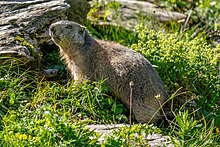阿尔卑斯旱獭
外观
| 阿尔卑斯旱獭 | |
|---|---|

| |
| 科学分类 | |
| 界: | 动物界 Animalia |
| 门: | 脊索动物门 Chordata |
| 纲: | 哺乳纲 Mammalia |
| 目: | 啮齿目 Rodentia |
| 科: | 松鼠科 Sciuridae |
| 属: | 旱獭属 Marmota |
| 种: | 阿尔卑斯旱獭 M. marmota
|
| 二名法 | |
| Marmota marmota | |

| |
| 异名 | |
| |
阿尔卑斯旱獭(学名:Marmota marmota)是旱獭属的模式种,生活在中、南欧海拔800—3,200米(2,600—10,500英尺)的阿尔卑斯山、喀尔巴阡山、塔特拉山和亚平宁山脉地区,1948年又引入比利牛斯山地区,其实比利牛斯山本来存在阿尔卑斯旱獭,但在更新世灭绝。[2]
特征
[编辑]

成年体体长43—73厘米(17—29英寸),尾巴长13—20厘米(5.1—7.9英寸),体重1.9—8千克(4.2—17.6英磅),春天刚结束冬眠的体重比秋季轻得多[3]。它有时被视为最重的松鼠科生物,但实际上同属的其他生物也可以达到这样的重量[3][4]。
习性
[编辑]阿尔卑斯旱獭是一种杂食动物,吃草和各种昆虫、蜘蛛,每天早晚天气凉爽时出来觅食。它们不是很耐热,因此天气炎热时食欲不佳。[5] 两岁大的阿尔卑斯旱獭就已性成熟,在春季交配,约33天产仔。占有统治地位的雌性阿尔卑斯旱獭会袭击怀孕的同类,甚至杀死幼崽[6]。饲养的阿尔卑斯旱獭寿命在15至18年左右。[5]
与人类的关系
[编辑]
欧洲人曾经相信阿尔卑斯旱獭的脂肪可以涂在皮肤上治疗风湿病,因此大规模地狩猎该物种,有时也将其作为食物捕杀。但是阿尔卑斯旱獭的整体种群数量并没有因此受到太大的威胁,只有德国等部分地区的数量有下降趋势。[1]
参考文献
[编辑]- ^ 1.0 1.1 Herrero, J.; Zima, J. & Coroiu, I. Marmota marmota. The IUCN Red List of Threatened Species. 2008 [31 December 2014].
- ^ J. Herrero; J. Canut; D. Garcia-Ferre; R. Garcia Gonzalez; R. Hidalgo. The alpine marmot (Marmota marmota L.) in the Spanish Pyrenees (PDF). Zeitschrift für Säugetierkunde. 1992, 57 (4): 211–215 [2010-11-13]. (原始内容 (PDF)存档于2010-10-01).
- ^ 3.0 3.1 Kryštufek, B.; B. Vohralík. Taxonomic revision of the Palaearctic rodents (Rodentia). Part 2. Sciuridae: Urocitellus, Marmota and Sciurotamias. Lynx, n. s. (Praha). 2013, 44: 27–138.
- ^ Armitage, K.B.; Blumstein, D.T. Body-mass diversity in marmots. Holarctic marmots as a factor of biodiversity. K.B. Armitage; V.Yu. Rumiantsev (编). Holarctic Marmots as a Factor of Biodiversity. ABF Publishing House. 2002: 22–32.
- ^ 5.0 5.1 Wildlife Fact File. IMP Publishing Ltd. 1994. Group 1, Card 146. OCLC 671298004.
- ^ Klaus Hackländera, Erich Möstlb and Walter Arnold. (2003) "Reproductive suppression in female Alpine marmots, Marmota marmota" Animal Behaviour 65(6):1133-1140.
外部连接
[编辑] 维基共享资源上的相关多媒体资源:Marmota marmota
维基共享资源上的相关多媒体资源:Marmota marmota

